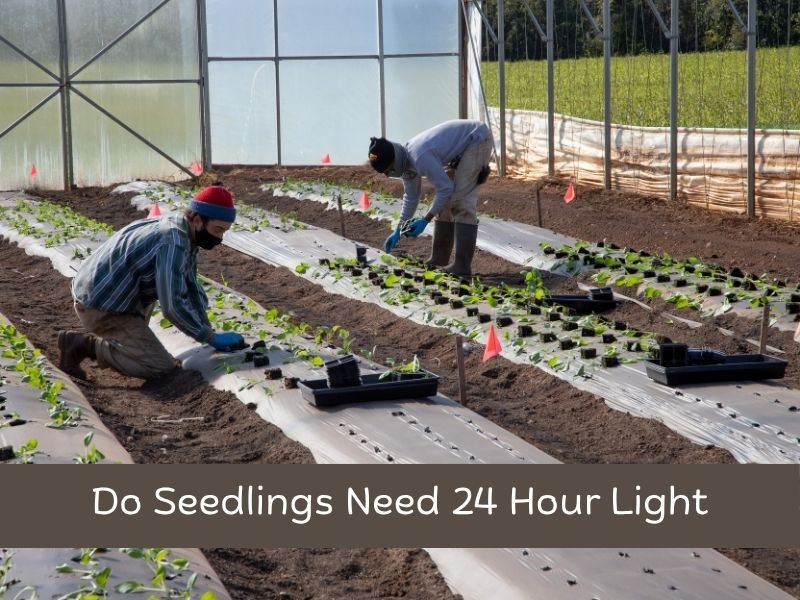Growing healthy seedlings indoors requires careful attention to their light exposure. While it might seem beneficial to provide constant light, understanding the balance between light and darkness is crucial for optimal growth.
Just like humans, plants have internal biological clocks known as circadian rhythms. These rhythms help regulate various physiological processes, including photosynthesis, nutrient uptake, and hormone production. When plants are exposed to continuous light, their circadian rhythms can become disrupted. This disruption can lead to a range of issues, from altered growth patterns to reduced stress resilience.
A 2017 study published in The Plant Journal emphasised how crucial these rhythms are for maintaining overall plant health and optimising photosynthetic performance. Continuous exposure to light can cause “photosynthetic fatigue,” a phenomenon where the efficiency of light utilisation declines over time due to a lack of recovery during dark periods.
Understanding Seedling Growth and Light
Light is essential for photosynthesis, the process by which plants convert light energy into chemical energy to fuel growth. However, darkness also plays a vital role in plant development. During dark periods, plants engage in respiration, a process that helps in energy distribution and growth regulation. Moreover, darkness influences hormone production, such as auxins, which are critical for cell elongation and differentiation. Disrupting the natural light-dark cycle can lead to imbalances in these processes, potentially affecting seedling health.
Can Seedlings Grow Under 24-Hour Light?
Technically, seedlings can grow under continuous light, and some growers use this method to accelerate early growth stages. However, constant light exposure can lead to issues such as leaf burn, growth abnormalities, and disrupted circadian rhythms. Plants have evolved to thrive under natural light-dark cycles, and deviating from this pattern can cause stress and reduce overall plant vigour.
Recommended Light Cycles for Seedlings
Most horticultural experts recommend providing seedlings with 14 to 16 hours of light per day, followed by 8 to 10 hours of darkness. This schedule mimics natural daylight patterns and supports healthy growth. For instance, the University of Minnesota Extension advises 16 to 18 hours of light daily for seedlings. Adjustments may be necessary based on plant type and light intensity. For example, tomato seedlings may require up to 22 hours under fluorescent light to match the energy received from just five hours of full sun.
Pros and Cons of 24-Hour Lighting
Pros:
- Accelerated early growth in some plant species.
- Simplified lighting setup without timers.
Cons:
- Increased energy consumption and higher costs.
- Potential for plant stress and reduced hardiness.
- Disruption of natural growth cycles and hormone production.
Expert and Scientific Perspectives
Research indicates that light-dark cycles are crucial for optimal plant health. A study published in the Frontiers in Plant Science journal highlights the importance of these cycles in regulating photosynthetic pathways. Additionally, the University of New Hampshire Extension notes that different light sources emit varying quantities of light, affecting the duration needed for seedlings to receive adequate energy.
Best Practices for Lighting Seedlings
- Choose the Right Light Schedule: Aim for 14 to 16 hours of light followed by 8 to 10 hours of darkness daily.
- Use Timers: Automated timers ensure consistent light cycles, reducing the risk of human error.
- Monitor Plant Responses: Watch for signs of overexposure, such as leaf curling or discolouration, and adjust light intensity or duration accordingly.
- Transitioning Outdoors: Gradually acclimate seedlings to natural light by increasing outdoor exposure over several days, a process known as hardening off.
Understanding the Role of Circadian Rhythms in Plants
Just like humans, plants have internal biological clocks known as circadian rhythms. These rhythms help regulate various physiological processes, including photosynthesis, nutrient uptake, and hormone production. When plants are exposed to continuous light, their circadian rhythms can become disrupted. This disruption can lead to a range of issues, from altered growth patterns to reduced stress resilience.
A 2017 study published in The Plant Journal emphasised how crucial these rhythms are for maintaining overall plant health and optimising photosynthetic performance. Continuous exposure to light can cause “photosynthetic fatigue,” a phenomenon where the efficiency of light utilisation declines over time due to a lack of recovery during dark periods.
Choosing the Right Grow Lights for Seedlings
The type of grow light you use also impacts how long seedlings should be exposed to it. Here’s a quick breakdown of popular lighting options:
- Fluorescent Lights (T5, T8): These are commonly used for seedlings due to their low heat output and moderate light intensity. They typically require 16–18 hours of use daily to provide enough light energy.
- LED Grow Lights: Modern full-spectrum LEDS are energy-efficient and versatile. Because of their intensity, many LED setups only need 12–16 hours of exposure, depending on the plant type.
- High-Intensity Discharge (HID) Lights: These are more suited for mature plants or flowering stages, but can be used for seedlings if properly distanced to avoid heat stress.
The University of Missouri Extension provides a helpful overview of how different lighting technologies affect plant growth.
How to Tell if Your Seedlings Are Getting Too Much Light
Even if you’re sticking to recommended light cycles, it’s important to observe your seedlings for signs of stress. Here are some indicators that your seedlings may be getting too much light:
- Leaf Curling or Wilting: If leaves start curling upward or downward without any signs of water deficiency, light stress might be the culprit.
- Discolouration or Bleaching: Pale, yellow, or white patches on the leaves can indicate light burn, especially under strong LEDS.
- Stunted Growth: While it might seem counterintuitive, too much light without adequate rest can slow down growth.
Adjusting the distance between the light source and the seedlings, reducing exposure time, or dimming the lights (if your setup allows) can help mitigate these symptoms.
When Might 24-Hour Light Be Useful?
There are a few scenarios where continuous light may be beneficial—or at least not harmful—for certain plant types:
- In Controlled Environments for Leafy Greens: Some fast-growing greens, like lettuce or spinach, can tolerate extended light cycles during their earliest stages. Commercial growers sometimes use 24-hour light for a brief period to speed up production.
- For Specialised Crops (e.g., Cannabis): Some cannabis growers use 24/0 light schedules during the vegetative phase to maximise growth before flowering. However, this practice is often debated and depends on strain-specific traits.
Still, even in these cases, most experts recommend a break in lighting to allow for healthy hormone regulation and rest.
Energy Efficiency and Environmental Considerations
Running grow lights 24/7 isn’t just questionable for plant health—it also increases energy consumption significantly. This translates to higher utility bills and a larger environmental footprint, especially if your energy source isn’t renewable. By using a timer and adhering to a light-dark cycle, you can promote sustainable gardening practices without compromising plant health.
Energy.gov suggests using LED grow lights and automatic timers to reduce household electricity use in indoor gardening.
Light Cycle Recommendations by Plant Type
| Plant Type | Recommended Light Schedule | Notes |
|---|---|---|
| Tomatoes | 16–18 hours light / 6–8 dark | Can handle long light periods but benefits from dark rest |
| Peppers | 14–16 hours light / 8–10 dark | Prefer moderate exposure with consistent cycles |
| Lettuce/Greens | 16–24 hours in the early stage | Tolerant of longer exposure, but best with breaks |
| Cannabis (veg.) | 18–24 hours of light | 18/6 or 20/4 is generally preferred for balance |
| Herbs (basil, cilantro) | 12–16 hours light / 8–12 dark | Require balance for aroma and oil production |
Use this table as a starting point and adjust based on the variety and your setup.
Practical Tips for Indoor Gardeners
- Use a Timer: This is the easiest way to maintain a consistent light cycle without needing to remember to turn lights on/off manually.
- Keep Lights at the Right Distance: Depending on the wattage and type of light, keep LEDS around 12–24 inches from the top of the seedlings.
- Observe and Adjust: Every growing environment is unique. Factors like humidity, temperature, and airflow also influence how plants respond to light.
- Introduce Darkness Slowly: If your seedlings have been under constant light, don’t switch abruptly to a dark cycle. Gradually reduce exposure over several days to minimise shock.
Conclusion
In conclusion, while seedlings can technically survive under 24-hour light, it’s rarely the best approach for long-term health. Continuous lighting can stress the plants, disrupt their natural rhythms, and even reduce vigour when transplanted outdoors.
A balanced light-dark cycle not only promotes healthier, more resilient seedlings but also helps you grow more sustainably. By sticking to a proven lighting schedule, using energy-efficient lighting systems, and observing your seedlings, you’ll set the stage for a thriving garden season.
FAQs
Can I use natural light for seedlings?
Yes, but natural light may not provide consistent intensity or duration, especially during shorter days. Supplementing with grow lights ensures seedlings receive adequate light for healthy growth.
Is darkness necessary for all plant types?
While some plants can tolerate extended light periods, most benefit from a regular light-dark cycle to support natural growth processes.
What happens if I forget to turn the lights off?
Occasional lapses are unlikely to cause significant harm, but consistently neglecting dark periods can stress plants and impede development.






